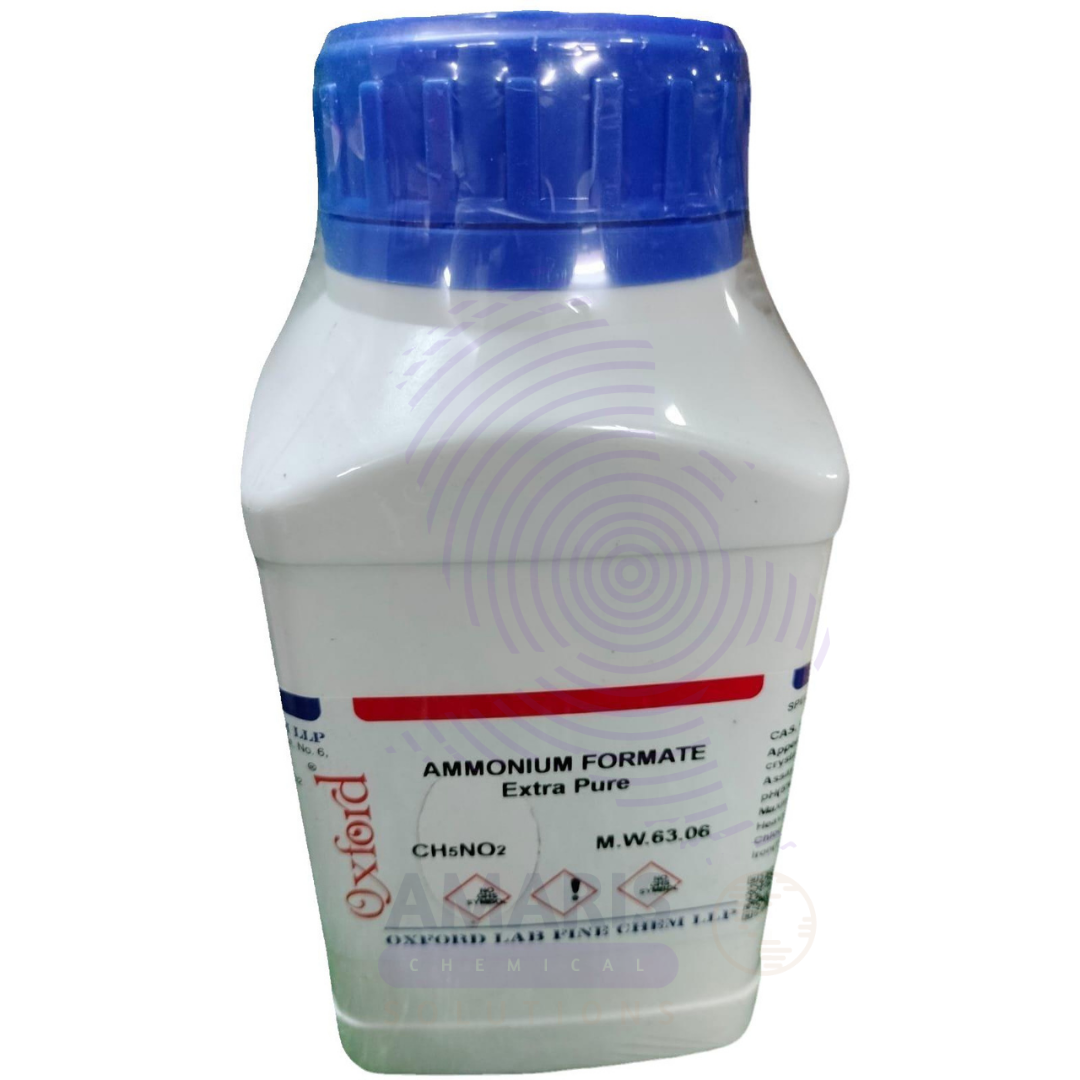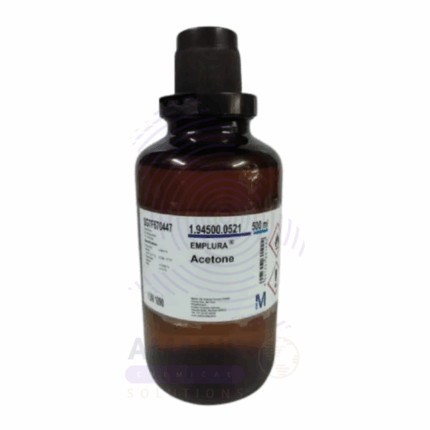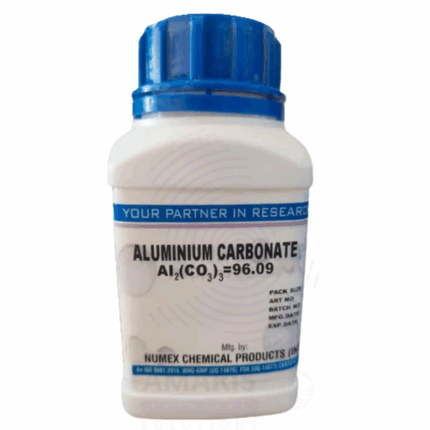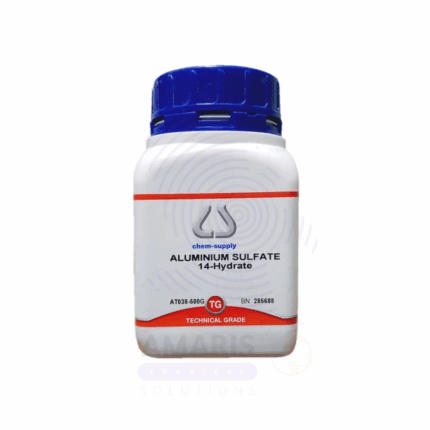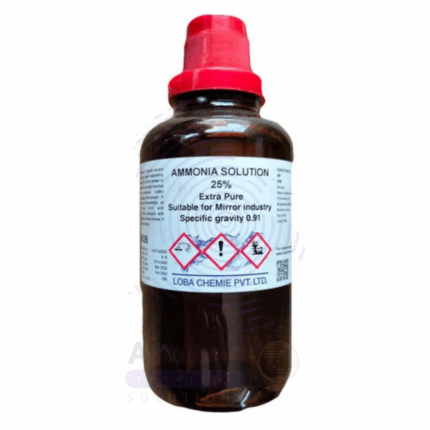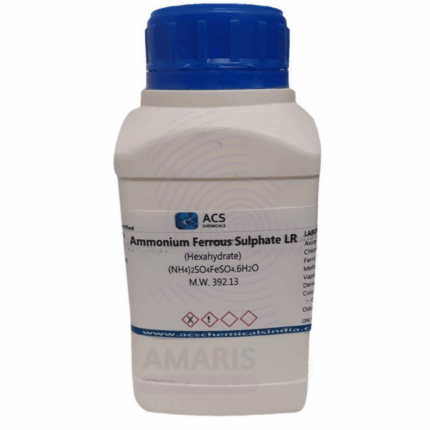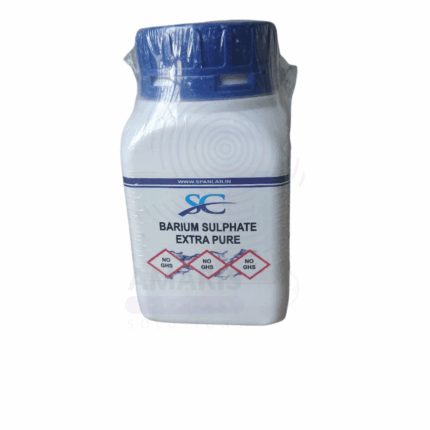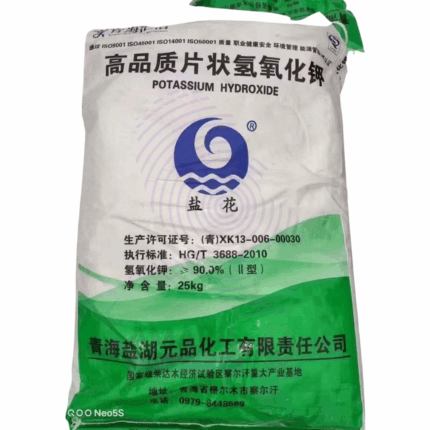
Ammonium Formate Extra Pure
$ 19.00 Original price was: $ 19.00.$ 18.21Current price is: $ 18.21.
Ammonium Formate Extra Pure is a high-purity, white crystalline compound commonly used in laboratory chemistry as a buffering agent, reducing agent, and reagent in organic synthesis. It plays a significant role in catalytic hydrogenation reactions, particularly in transfer hydrogenation using palladium or platinum catalysts. In analytical chemistry, it is frequently used in HPLC and mass spectrometry applications due to its volatility and compatibility with aqueous and organic mobile phases. The extra pure grade ensures extremely low levels of impurities, making it suitable for high-precision and instrument-sensitive applications. It should be stored in a cool, dry, and tightly sealed container to preserve its stability and prevent moisture uptake.
Ammonium Formate Extra Pure
Primary Uses
- Buffer Component in LC-MS and HPLC
- Commonly used to prepare volatile buffers for liquid chromatography-mass spectrometry due to minimal residue upon evaporation.
- Reagent in Reductive Amination and Hydrogenation
- Acts as a hydrogen donor in the presence of catalysts like Pd/C for mild reduction of nitro groups, imines, and aldehydes in organic synthesis.
- Source of Formate Ions in Analytical Chemistry
- Supplies formate in studies of weak acid salts, buffer systems, and ion exchange processes.
- pH Control in Biochemical Assays
- Used in low-salt, mildly acidic buffer preparations in enzymology or protein chemistry experiments.
- Intermediate in Syntheses of Fine Chemicals
- Involved in the lab-scale synthesis of pharmaceuticals, APIs, and heterocyclic intermediates.
Secondary Uses
- Volatile Additive in Electrospray Ionization (ESI-MS)
- Enhances ionization of analytes in mass spectrometry with minimal contamination or memory effects.
- Reductive Quenching Agent in Photochemistry
- Acts as an electron/hydrogen donor in photoredox catalysis or dye-sensitized reaction studies.
- Study of Decomposition and Thermal Behavior
- Used in TGA or decomposition studies to understand release of ammonia, CO, and H₂ under heat.
- Experimental Solvent Additive in Peptide Mapping
- Enhances ionization and retention behavior in LC-MS of peptides and small biomolecules.
- Demonstration of Acid–Base Equilibria
- Shows properties of weak acid–weak base salts in undergraduate teaching labs.
| PACK SIZE |
250 grams Plastic Tin |
|---|
1. Basic Identification Attributes
- Chemical Name: Ammonium Formate
- CAS Number: 540-69-2
- HS Code: 29151200 (Salts of formic acid)
- Molecular Formula: NH₄HCOO
- Synonyms:
- Formic acid ammonium salt
- Ammonium methanoate
- Ammonium formiate
2. Physical & Chemical Properties
- Physical State: Solid (crystalline powder)
- Color & Odor: White crystals; faint formic or ammonia-like odor
- Boiling Point: Decomposes before boiling
- Melting Point: ~116–120°C (decomposes)
- Density/Specific Gravity: ~1.28 g/cm³
- Solubility:
- Water: Very soluble (~1,600 g/L at 25°C)
- Alcohol: Soluble
- pH Level: ~6.4–6.8 (in 5% aqueous solution; near neutral)
- Vapor Pressure: Negligible (solid)
- Flash Point: Not flammable
- Autoignition Temperature: Not applicable
- Viscosity: Not applicable
3. Safety & Hazard Attributes
- Hazard Class (GHS):
- Not classified as hazardous under GHS in small lab quantities
- May cause mild eye/skin irritation
- NFPA Ratings:
- Health: 1
- Flammability: 0
- Reactivity: 0
- Exposure Limits:
- No established OSHA/ACGIH limits
- General nuisance dust precautions apply
- Reactivity:
- Stable under standard conditions
- Decomposes upon heating to produce formamide and water
- Incompatible with strong acids and oxidizers
4. Storage & Handling Attributes
- Storage Conditions:
- Store in a tightly closed container
- Keep in a cool, dry, well-ventilated area
- Incompatible Materials:
- Strong acids, bases, oxidizers
- Container Type:
- HDPE or tightly sealed glass
- Shelf Life & Expiration Date:
- ~2 years if stored dry and cool
- Special Handling Requirements:
- Use gloves and goggles
- Avoid creating or inhaling dust
5. Regulatory & Compliance Attributes
- Regulatory Status:
- Listed under TSCA and REACH
- No special transport restrictions for lab use
- Hazard Symbols (GHS Pictograms):
- Not required unless large quantities are used
- Transportation Restrictions:
- Not classified as a hazardous material
- Waste Disposal Method:
- Dilute in water and neutralize with acid or base
- Dispose of according to institutional waste policies
6. Environmental & Health Impact
- Ecotoxicity:
- Low environmental hazard
- Persistence in Environment:
- Biodegradable; dissociates into naturally occurring ions
- Carcinogenicity/Mutagenicity:
- Not classified as carcinogenic or mutagenic
- Biodegradability:
- Readily biodegradable
SAFETY PRECAUTIONS
- Personal Protective Equipment (PPE):
- Wear a lab coat, chemical splash goggles, and chemical-resistant gloves (e.g., nitrile).
- Use in a well-ventilated area or under a fume hood to minimize dust or vapor exposure.
- Handling:
- Handle carefully to avoid creating dust or spillage.
- Avoid contact with eyes, skin, and clothing.
- Do not breathe dust or decomposition fumes.
- Avoid contact with acids and strong oxidizing agents (may release formic acid or ammonia).
- Storage:
- Store in a tightly sealed container in a cool, dry, well-ventilated area.
- Protect from moisture and heat.
- Keep away from incompatible substances such as acids, oxidizers, and bases.
- Hygiene Measures:
- Wash hands thoroughly after handling.
- Do not eat, drink, or smoke in the lab.
- Keep work surfaces clean and decontaminate after use.
FIRST AID MEASURES
- Inhalation:
- Move to fresh air immediately.
- Seek medical attention if respiratory symptoms occur.
- Provide oxygen or artificial respiration if breathing becomes difficult.
- Skin Contact:
- Remove contaminated clothing.
- Wash affected skin with soap and water.
- Seek medical attention if irritation develops.
- Eye Contact:
- Flush eyes with plenty of water for at least 15 minutes.
- Remove contact lenses if present and easy to do.
- Seek medical attention if irritation or redness persists.
- Ingestion:
- Rinse mouth with water.
- Do not induce vomiting.
- If the person is conscious, give water to dilute.
- Seek immediate medical attention—formate salts can be harmful if ingested in quantity.
FIRE FIGHTING MEASURES
- Suitable Extinguishing Media:
- Use dry chemicals, carbon dioxide (CO₂), alcohol-resistant foam, or water spray, depending on the surrounding materials.
- Specific Hazards:
- Combustion or decomposition may produce toxic fumes, including:
- Ammonia
- Formic acid
- Nitrogen oxides (NOₓ)
- Combustion or decomposition may produce toxic fumes, including:
- Protective Equipment for Firefighters:
- Wear self-contained breathing apparatus (SCBA) and full protective gear.
- Firefighting Instructions:
- Avoid inhaling fumes or vapors.
- Cool fire-exposed containers with water spray.
- Prevent run-off from contaminating water systems—can be harmful to aquatic life.


 Preservatives(food)
Preservatives(food) Flavor Enhancers
Flavor Enhancers Acidulants
Acidulants Sweeteners
Sweeteners Antioxidants
Antioxidants Colorants(food)
Colorants(food) Nutraceutical Ingredients (food)
Nutraceutical Ingredients (food) Nutrient Supplements
Nutrient Supplements Emulsifiers
Emulsifiers
 Collectors
Collectors Dust Suppressants
Dust Suppressants Explosives and Blasting Agents
Explosives and Blasting Agents Flocculants and Coagulants
Flocculants and Coagulants Frothers
Frothers Leaching Agents
Leaching Agents pH Modifiers
pH Modifiers Precious Metal Extraction Agents
Precious Metal Extraction Agents
 Antioxidants(plastic)
Antioxidants(plastic) Colorants (Pigments, Dyes)
Colorants (Pigments, Dyes) Fillers and Reinforcements
Fillers and Reinforcements Flame Retardants
Flame Retardants Monomers
Monomers Plasticizers
Plasticizers Polymerization Initiators
Polymerization Initiators Stabilizers (UV, Heat)
Stabilizers (UV, Heat)
 Antifoaming Agents
Antifoaming Agents Chelating Agents
Chelating Agents Coagulants and Flocculants
Coagulants and Flocculants Corrosion Inhibitors
Corrosion Inhibitors Disinfectants and Biocides
Disinfectants and Biocides Oxidizing Agents
Oxidizing Agents pH Adjusters
pH Adjusters Scale Inhibitors( water)
Scale Inhibitors( water)
 Antioxidants(cosmetic)
Antioxidants(cosmetic) Emollients
Emollients Fragrances and Essential Oils
Fragrances and Essential Oils Humectants
Humectants Preservatives
Preservatives Surfactants(cosmetic)
Surfactants(cosmetic) Thickeners
Thickeners UV Filters
UV Filters
 Fertilizers
Fertilizers Soil Conditioners
Soil Conditioners Plant Growth Regulators
Plant Growth Regulators Animal Feed Additives
Animal Feed Additives Biostimulants
Biostimulants Pesticides (Herbicides, Insecticides, Fungicides)
Pesticides (Herbicides, Insecticides, Fungicides)
 Active Pharmaceutical Ingredients (APIs)
Active Pharmaceutical Ingredients (APIs) Excipients
Excipients Solvents(pharmaceutical)
Solvents(pharmaceutical) Antibiotics
Antibiotics Antiseptics and Disinfectants
Antiseptics and Disinfectants Vaccine Adjuvants
Vaccine Adjuvants Nutraceutical Ingredients (pharmaceutical)
Nutraceutical Ingredients (pharmaceutical) Analgesics & Antipyretics
Analgesics & Antipyretics
 Analytical Reagents
Analytical Reagents Solvents(lab)
Solvents(lab) Chromatography Chemicals
Chromatography Chemicals Spectroscopy Reagents
Spectroscopy Reagents microbiology-and-cell-culture-reagents
microbiology-and-cell-culture-reagents Molecular Biology Reagents
Molecular Biology Reagents Biochemical Reagents
Biochemical Reagents Inorganic and Organic Standards
Inorganic and Organic Standards Laboratory Safety Chemicals
Laboratory Safety Chemicals Specialty Laboratory Chemicals(Special Laboratory Equipment)
Specialty Laboratory Chemicals(Special Laboratory Equipment)
 Demulsifiers
Demulsifiers Hydraulic Fracturing Fluids
Hydraulic Fracturing Fluids Scale Inhibitors(oil)
Scale Inhibitors(oil) Surfactants(oil)
Surfactants(oil) Drilling Fluids
Drilling Fluids
 Dyes and Pigments
Dyes and Pigments Bleaching Agents
Bleaching Agents Softening Agents
Softening Agents Finishing Agents
Finishing Agents Antistatic Agents
Antistatic Agents
 Admixtures
Admixtures Waterproofing Agents
Waterproofing Agents Sealants and Adhesives
Sealants and Adhesives Curing Compounds
Curing Compounds Concrete Repair Chemicals
Concrete Repair Chemicals Anti-Corrosion Coatings
Anti-Corrosion Coatings
 Surfactants(cleaning)
Surfactants(cleaning) Builders
Builders Enzymes
Enzymes Solvents (Cleaning)
Solvents (Cleaning) Fragrances
Fragrances
 Electronic Chemicals
Electronic Chemicals Catalysts
Catalysts Lubricants
Lubricants Photographic Chemicals
Photographic Chemicals Refrigerants
Refrigerants Automotive chemicals
Automotive chemicals Pyrotechnic Chemicals
Pyrotechnic Chemicals
 Biodegradable Surfactants
Biodegradable Surfactants Bio-based Solvents
Bio-based Solvents Renewable Polymers
Renewable Polymers Carbon Capture Chemicals
Carbon Capture Chemicals Wastewater Treatment Chemicals
Wastewater Treatment Chemicals
 Pigments
Pigments Solvents(paint)
Solvents(paint) Specialty Coatings
Specialty Coatings Binders/Resins
Binders/Resins Additives
Additives Driers
Driers Anti-Corrosion Agents
Anti-Corrosion Agents Functional Coatings
Functional Coatings Application-Specific Coatings
Application-Specific Coatings
 Fresh Herbs
Fresh Herbs Ground Spices
Ground Spices Whole Spices
Whole Spices Spice Blends
Spice Blends Dried Herbs
Dried Herbs
 Leavening Agents
Leavening Agents Dough Conditioners
Dough Conditioners Flour Treatments
Flour Treatments Fat Replacers
Fat Replacers Decoratives
Decoratives Preservatives(baking)
Preservatives(baking)
 Plasticizers & Softeners
Plasticizers & Softeners Reinforcing Agents
Reinforcing Agents Adhesion Promoters
Adhesion Promoters Vulcanizing Agents
Vulcanizing Agents Antidegradants
Antidegradants Blowing Agents
Blowing Agents Fillers & Extenders
Fillers & Extenders Accelerators & Retarders
Accelerators & Retarders